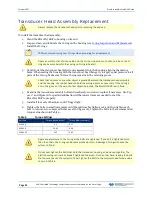
RiverPro and RioPro ADCP Guide
October 2017
EAR-Controlled Technology Subject to Restrictions Contained on the Cover Page.
Page 51
O-ring Inspection and Replacement
This section explains how to inspect/replace the RiverPro/RioPro O-rings. A successful deployment de-
pends on the condition of four O-rings and their retaining grooves. Read all instructions before doing the
required actions.
RiverPro
•
Transducer and End-cap assembly, face, 2-253
•
Transducer and End-cap assembly, bore, 2-159
RioPro
•
Transducer and End-cap assembly, 2-260
TRDI strongly recommend replacing these O-rings whenever the RiverPro/RioPro is disassembled. In-
specting and replacing the O-rings should be the last maintenance task done before sealing the
RiverPro/RioPro.
TRDI recommends using new O-rings when preparing for a deployment.
To replace/inspect the O-ring:
1. Inspect the O-rings. When viewed with an unaided eye, the O-rings must be free of cuts, indenta-
tions, abrasions, foreign matter, and flow marks. The O-ring must be smooth and uniform in ap-
pearance. Defects must be less than 0.1 mm (0.004 in.).
Always use new O-rings. Weak or damaged O-rings will cause the RiverPro/RioPro to flood.
2. Clean and inspect the O-ring grooves. Be sure the grooves are free of foreign matter, scratches,
indentations, corrosion, and pitting. Run your fingernail across damaged areas. If you cannot feel
the defect, the damage may be minor; otherwise, the damage may need repair.
Check the O-ring groove thoroughly. Any foreign matter in the O-ring groove will cause the
RiverPro/RioPro to flood.
3. If a scratch is on the plastic housing flange O-ring groove, it may be gently sanded using 600-grit
(wet) sandpaper. Use care not to cause further damage.
4. Lubricate the O-ring with a thin coat of silicone lubricant. Use as little lubricant as possible - just a
sufficient amount to change the color of the O-ring. Apply the lubricant using latex gloves. Do not
let loose fibers or lint stick to the O-ring. Fibers can provide a leakage path.
Apply a very thin coat of silicone lube on the O-ring. Using too much silicone lube on the O-
ring can be more harmful than using no O-ring lube at all.
















































